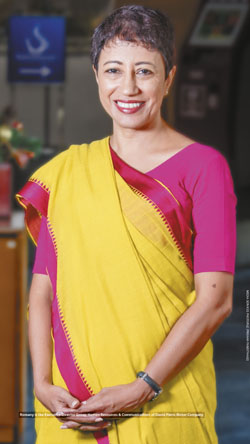BRANDING STRATEGY

Romany Parakrama
BRAND COMMUNICATIONS SPRINT WITH CARE!

How have marketing communication tools evolved with digitisation?
Digitisation represents a change that is even greater than the internet. The proliferation of digital channels and devices offers consumers greater access to information, as well as platforms for communication and collaboration. So the way consumers engage with businesses and each other has changed fundamentally.
Previously, consumers relied on brands to provide information and price comparisons, whereas they now have real-time access by simply scanning a product barcode to compare information on a smartphone application. Price transparency has increased due to this.
Moreover, today’s consumers trust each other more than they trust corporations and their brands – this is evidenced by the 78 percent who trust peer recommendations compared to 14 percent who believe advertisements.
Generation Y plays a major role in accelerating the evolution of the new digital world. Their expectations are driven by the technologies with which they surround themselves. And they already constitute a new and rapidly growing category of consumers and employees who are networked, collaborative and highly social.
To remain competitive, companies should intellectually accept digital developments and transform the corporate mindset to align with digitisation. These changes call for a very different set of skills and thinking. As communicators, we need to be agile and adaptable.
In what way does being connected enhance a brand’s image?
It is no longer about merely enhancing a brand’s image; it’s about survival. Digitalisation warrants a different set of practices to connect consumers and brands. It calls for the infinite reproduction of content, consumer networking, user-generated content, and expansion of channels from news and entertainment to any technology that has a digital interface with people.
No longer can brands say one thing and do another – the digital data trail has offered consumers the tools to virally spread their views about a brand. This has significant implications for the management of brand reputation.
What strategies should be adopted to retain an audience’s attention in this age of multiple disruptive communications?
The key is to understand that we can’t control the message and be the single source of information on our brand.
There are some basics to which we must adhere – such as customer focus, interactivity and consistency – to create a uniform and unique image. In an uncontrolled, co-created and transparent media environment, your engagements should be authentic, direct and personal.
We need to bear in mind that social media was made for people, not brands. People expect real stories instead of marketing messages. Brands need to begin conversations and attract attention. But once a message is transmitted, you cannot control its outcome. So a great deal of thought must go into whether you want to start a conversation.
And time is of the essence. The information you convey has to be current and relevant. This is particularly important in dealing with issues and responding to customer queries.
Shouldn’t there be a regulatory framework to ensure that marketing communications do not violate social or ethical values?
In an era of digitisation, it is next to impossible to enforce a regulatory framework. At best, it could merely be a deterrent.
A positive outcome of digitisation is that due to the rapid and unpredictable spread of information across multiple platforms, the public is empowered to take a stance on communications. They’ll make noise and express outrage about what they feel is unsuitable, and then boycott it.
So communicators and businesses must review and self-regulate – or pay the price.
Do you believe that Sri Lanka has a viable country branding strategy?
No. A brand is not merely a clever tag line or logo. It is about perceived value and emotion – the intangible sum of a product; or in this case, Sri Lanka’s attributes.
A brand provides an effective approach to create a consistent, distinct and strong story that enables companies or products to stand out. Built with consistency, it offers tremendous economic leverage and strategic advantages for products and services that are associated with the country.
How long have you been associated with marketing communications?
I am a banker turned communicator. And I’ve been in this field for over 11 years. Marketing communications is only one aspect of a communicator’s role that encompasses internal, leadership and customer communications, as well as regulator and investor relations, and crisis and issue management.
Describe yourself in one word…
Unconventional
What is your mantra for success?
‘Never compromise on values and principles.’
Romany is the Executive Director Group Human Resources & Communications of David Pieris Motor Company
– Compiled by Hansani Bandara





Leave a comment